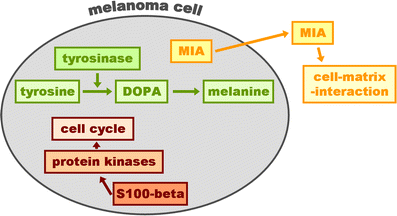Serologic and immunohistochemical prognostic biomarkers of cutaneous malignancies
- PMID: 17221215
- PMCID: PMC1800369
- DOI: 10.1007/s00403-006-0726-5
Serologic and immunohistochemical prognostic biomarkers of cutaneous malignancies
Abstract
Biomarkers are important tools in clinical diagnosis and prognostic classification of various cutaneous malignancies. Besides clinical and histopathological aspects (e.g. anatomic site and type of the primary tumour, tumour size and invasion depth, ulceration, vascular invasion), an increasing variety of molecular markers have been identified, providing the possibility of a more detailed diagnostic and prognostic subgrouping of tumour entities, up to even changing existing classification systems. Recently published gene expression or proteomic profiling data relate to new marker molecules involved in skin cancer pathogenesis, which may, after validation by suitable studies, represent future prognostic or predictive biomarkers in cutaneous malignancies. We, here, give an overview on currently known serologic and newer immunohistochemical biomarker molecules in the most common cutaneous malignancies, malignant melanoma, squamous cell carcinoma and cutaneous lymphoma, particularly emphasizing their prognostic and predictive significance.
Figures


References
-
- {'text': '', 'ref_index': 1, 'ids': [{'type': 'DOI', 'value': '10.1046/j.1365-2133.2002.04691.x', 'is_inner': False, 'url': 'https://doi.org/10.1046/j.1365-2133.2002.04691.x'}, {'type': 'PubMed', 'value': '12000380', 'is_inner': True, 'url': 'https://pubmed.ncbi.nlm.nih.gov/12000380/'}]}
- Acland K, Evans AV, Abraha H, Healy CM, Roblin P, Calonje E, Orchard G, Higgins E, Sherwood R, Russell-Jones R (2002) Serum S100 concentrations are not useful in predicting micrometastatic disease in cutaneous malignant melanoma. Br J Dermatol 146:832–835 - PubMed
-
- {'text': '', 'ref_index': 1, 'ids': [{'type': 'PubMed', 'value': '2564228', 'is_inner': True, 'url': 'https://pubmed.ncbi.nlm.nih.gov/2564228/'}]}
- Agrup P, Carstam R, Wittbjer A, Rorsman H, Rosengren E (1989) Tyrosinase activity in serum from patients with malignant melanoma. Acta Derm Venereol 69:120–124 - PubMed
-
- {'text': '', 'ref_index': 1, 'ids': [{'type': 'PMC', 'value': 'PMC1602212', 'is_inner': False, 'url': 'https://pmc.ncbi.nlm.nih.gov/articles/PMC1602212/'}, {'type': 'PubMed', 'value': '14695333', 'is_inner': True, 'url': 'https://pubmed.ncbi.nlm.nih.gov/14695333/'}]}
- Alonso SR, Ortiz P, Pollan M, Perez-Gomez B, Sanchez L, Acuna MJ, Pajares R, Martinez-Tello FJ, Hortelano CM, Piris MA, et al (2004) Progression in cutaneous malignant melanoma is associated with distinct expression profiles: a tissue microarray-based study. Am J Pathol 164:193–203 - PMC - PubMed
-
- {'text': '', 'ref_index': 1, 'ids': [{'type': 'DOI', 'value': '10.1038/modpathol.3800151', 'is_inner': False, 'url': 'https://doi.org/10.1038/modpathol.3800151'}, {'type': 'PubMed', 'value': '15133476', 'is_inner': True, 'url': 'https://pubmed.ncbi.nlm.nih.gov/15133476/'}]}
- Andersen K, Nesland JM, Holm R, Florenes VA, Fodstad O, Maelandsmo GM (2004) Expression of S100A4 combined with reduced E-cadherin expression predicts patient outcome in malignant melanoma. Mod Pathol 17:990–997 - PubMed
-
- {'text': '', 'ref_index': 1, 'ids': [{'type': 'DOI', 'value': '10.1158/1078-0432.CCR-05-0011', 'is_inner': False, 'url': 'https://doi.org/10.1158/1078-0432.ccr-05-0011'}, {'type': 'PubMed', 'value': '16361544', 'is_inner': True, 'url': 'https://pubmed.ncbi.nlm.nih.gov/16361544/'}]}
- Bachmann IM, Straume O, Puntervoll HE, Kalvenes MB, Akslen LA (2005) Importance of P-cadherin, beta-catenin, and Wnt5a/frizzled for progression of melanocytic tumors and prognosis in cutaneous melanoma. Clin Cancer Res 11:8606–8614 - PubMed
Publication types
MeSH terms
Substances
LinkOut - more resources
Full Text Sources
Medical

